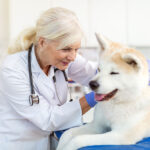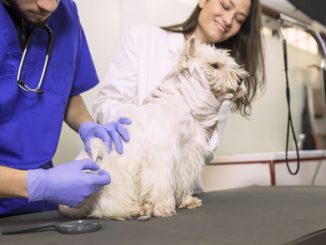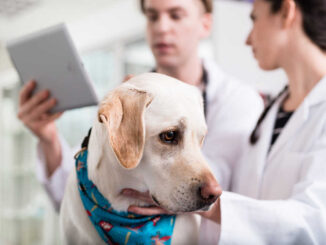
In my years as a veterinarian, I’ve frequently come across Cushing’s disease in dogs, a hormonal disorder that can manifest in myriad ways. While many are familiar with the general symptoms, the neurological aspects of this condition often remain less understood. In this article, I will focus on the neurological symptoms associated with Cushing’s disease.
Overview of Cushing’s Disease in relation to neurology in dogs
Cushing’s Disease, also known as hyperadrenocorticism, is a hormonal disorder that commonly affects middle-aged to older dogs. It is characterized by an overproduction of the stress hormone cortisol, typically caused by either an adrenal gland tumor or a pituitary gland tumor. This overproduction of cortisol often leads to:
- increased thirst and urination
- changes to skin and fur coat
- increased appetite
- pot-bellied appearance
Cushing’s Disease can also lead to neurological symptoms, primarily when a pituitary gland tumor is the underlying cause. These tumors can grow and exert pressure on the surrounding brain tissue, leading to neurological disturbances. Pituitary tumors are responsible for the majority of cases of Cushing’s Disease in dogs (approximately 85%).
Neurological signs associated with Cushing’s Disease in dogs
Neurological symptoms, such as those listed below, can occur in approximately 20% of dogs with pituitary-dependent Cushing’s Disease. They may occur before, at the same time, or after a diagnosis of Cushing’s. Additionally, it is important to note that there are other more common medical conditions that can cause similar neurological symptoms.
- Ataxia (Incoordination): Dogs may show signs of wobbliness or staggering when walking.
- Behavioral changes: Affected dogs may exhibit significant behavioral changes like restlessness, nervousness, irritability, lethargy, disorientation, and decreased appetite.
- Seizures: In some cases, the pressure exerted by a pituitary tumor can cause seizures.
- Head pressing: Dogs may press their head against the wall or other solid objects, an indication of a serious neurological issue.
- Circling or pacing: Continuous circling or pacing can be indicative of an underlying neurological issue related to the pituitary gland tumor.
Diagnosis of Cushing’s Disease in dogs with neurological signs
If you take your dog to the veterinarian to discuss neurological signs, possibly related to Cushing’s Disease or any other underlying condition, the following process is likely to occur:
- Thorough history: The veterinarian will ask you detailed questions about the signs you’ve observed, the duration of the symptoms, any potential incidents that might have led to them, and any relevant medical history.
- Clinical examination: A comprehensive physical and neurological examination will be performed. This may include checking your dog’s reflexes, gait, posture, and responses to stimuli to evaluate the nervous system’s function.
- Blood and urine tests: The vet may recommend laboratory tests, such as a complete blood count, chemistry panel, and urinalysis, to rule out other underlying conditions and look for indicators of Cushing’s Disease.
- Referral to neurologist: If necessary, more specialized neurological testing and imaging might be recommended with a specialist.
- Imaging: MRI, CT, and ultrasound may all be useful in determining an underlying cause.
- ACTH stimulation test or Low-Dose Dexamethasone Suppression test – These are blood tests used to diagnose Cushing’s Disease. Your veterinarian may also recommend additional tests to distinguish adrenal versus pituitary-dependent disease.
What to do when my dog shows neurological signs in relation to Cushing’s Disease
Any dog showing neurological signs must see a veterinarian. There are many possible underlying causes, many of which are serious or could impact the health of humans in the family as well. If your dog’s symptoms are determined to be due to Cushing’s Disease, your vet will be able to recommend an appropriate treatment plan.
Until you can get to your vet, document your dog’s clinical signs and keep them safe by removing any objects that might cause them injury during a neurological episode.
How your vet will help
Treatment for neurological signs associated with Cushing’s Disease may involve the following:
- Surgical Intervention: Adrenal tumors can often be removed surgically. If a pituitary tumor is causing neurological signs, surgical removal may be considered in some cases. However, this is a much more difficult procedure that requires specialized skills and facilities and is not without risks.
- Medical Management: Medications like mitotane and trilostane are commonly used to manage Cushing’s Disease caused by pituitary tumors. These medications interfere with the production of cortisol; however, they are not without side effects and require careful monitoring.
- Radiation Therapy: Radiation therapy is a targeted treatment that uses high-energy rays to destroy or shrink tumor cells. In the case of pituitary tumors causing neurological signs, radiation therapy may be used to reduce the size of the tumor, thereby alleviating pressure on surrounding brain structures.
- Symptomatic Treatment for Neurological Signs: Additional treatments may be recommended to help control neurological signs, for example, anticonvulsants, pain medications, and physical therapy.
Frequently Asked Questions
How does Cushing’s Disease lead to neurological signs in dogs?
Neurological signs can occur in dogs with pituitary tumors causing their Cushing’s Disease. The tumor can grow and exert pressure on surrounding areas of the brain, leading to these symptoms.
Is Cushing’s Disease in dogs curable?
Unless a tumor is surgically removed, there is no cure for Cushing’s Disease in dogs; however, the condition can generally be well managed with medications.
Can I manage the neurological signs without treating Cushing’s disease?
It’s essential to discuss your concerns and any limitations (such as financial constraints) with your veterinarian. Cushing’s Disease can put significant stress on other body symptoms and lead to other complications. While many cases are not curable, medical management is an excellent option and is highly recommended.
How can I help a dog with neurological signs while receiving treatment for Cushing’s Disease?
Discuss symptomatic treatment of neurological signs with your vet, in addition to management of underlying Cushing’s Disease.
Related articles about Cushing’s disease in dogs:
 Dog Cushing’s Disease Impact on Back Legs: Our Vet Explains - In my years as a veterinarian, I've frequently come across Cushing's disease in dogs, a… [...]
Dog Cushing’s Disease Impact on Back Legs: Our Vet Explains - In my years as a veterinarian, I've frequently come across Cushing's disease in dogs, a… [...] Pictures of Cushing’s Disease in Dogs, with Vet Explanations - This article presents 10 pictures of Cushing's disease in dogs to illustrate its most common… [...]
Pictures of Cushing’s Disease in Dogs, with Vet Explanations - This article presents 10 pictures of Cushing's disease in dogs to illustrate its most common… [...] What is My Dog’s Life Expectancy With Cushing’s Disease? A Vet Weighs In - Essentially, Cushing’s Disease is a hormonal imbalance. Let’s start with how things normally work. The… [...]
What is My Dog’s Life Expectancy With Cushing’s Disease? A Vet Weighs In - Essentially, Cushing’s Disease is a hormonal imbalance. Let’s start with how things normally work. The… [...] Signs that Your Dog is Dying from Cushing’s Disease - Making the decision to euthanize a dog with Cushing’s disease is not easy;. Due to… [...]
Signs that Your Dog is Dying from Cushing’s Disease - Making the decision to euthanize a dog with Cushing’s disease is not easy;. Due to… [...] When to Euthanize a Dog with Cushing’s disease? [Vet Advice] - Making the decision to euthanize a dog with Cushing’s disease is not an easy one… [...]
When to Euthanize a Dog with Cushing’s disease? [Vet Advice] - Making the decision to euthanize a dog with Cushing’s disease is not an easy one… [...]Disclaimer: This website's content is not a substitute for veterinary care. Always consult with your veterinarian for healthcare decisions. Read More.





Be the first to comment